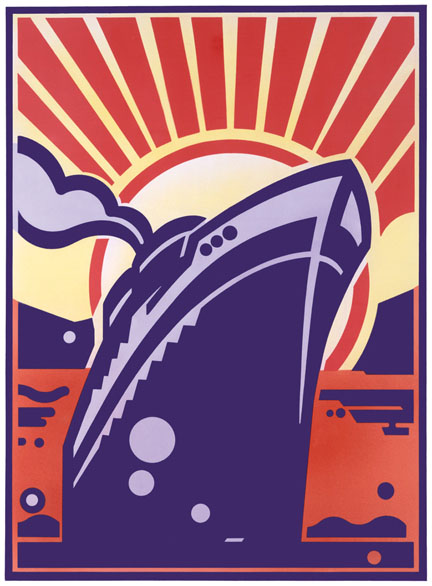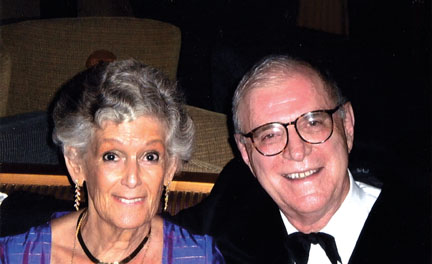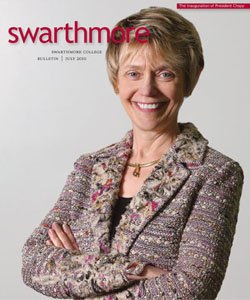Waltzing the South Atlantic
How I Survived a Luxury Cruise as a “Gentleman Host.”
DURING 35 YEARS IN THE CORPORATE WORLD, I encountered my share of job applications. But the one I filled out in June 2009 was the first that required a dance audition and a photograph of me in a tuxedo. The application wasn’t for a job per se but for a gig as a “gentleman host,” where, in exchange for free passage on a 30-day luxury cruise from Cape Town, South Africa, to Ft. Lauderdale, I would (mostly) dance with single ladies of a certain age.
At 74, retired for 12 years, my life had become stale and sedentary. I needed a new challenge. The role of gentleman host seemed perfect. I’d financed my first trip abroad—a student tour of Europe in 1955—by giving ballroom dance lessons and, ever since, I’ve loved to dance. I also love travel, especially at sea, and people —or so I thought.
After boarding the ship in Cape Town, I learned from Ellie, the ship’s social hostess and my supervisor, that my responsibilities would include much more than leading ladies through a few fox-trots and rumbas. I’d host a table of Solos (as both women and men traveling alone were known) at breakfast; assist with half-hour dance lessons twice a day; join Solos for cocktails; host Solos for dinner; accompany a Solo to the evening show; and, finally, dance with single women until midnight—a time when any sane person my age would already be in bed. I’d need to learn and use all of the Solos’ names—roughly 45 of them, greet everyone with a cordial “Good morning” or “Good evening,” and always smile, smile, smile! And, Ellie said, I must never enter a passenger’s stateroom under any circumstance. There must not be even a hint of impropriety.
At the opening cocktail party, I met the first of the Solos. Brenda was retired from a career in private banking and would soon become addicted to the onboard casino. Terry was a jolly former bookie from London, obviously on the prowl for a single woman. Patrick, an Australian, emphasized words by drawing out vowels and dramatically blinking his eyes. Shirley, a retired flight attendant, immediately announced I should be “ready,” because she loved to dance. And Mariella from Los Angeles was a sleek, Afghan hound–like divorcee who’d been married to several men (at separate times) in the movie industry.
Over the next day or two, I met more Solos. Gabriele was a 70-ish, slight and stylish widow with carefully coiffed gray hair and a long, gazelle-like neck, which at night was often encircled with a sparkling cuff of silver or gold. Born in Switzerland but now living in Florida, she spoke with a charming accent, calling me “Feel.” Always elegantly dressed, she favored the cha-cha, which she performed with a casual arms-over-the-shoulder ease that could only have been achieved through many lessons.
Then there were the Claudines—two French ladies in their 60s who spoke no English and were always beautifully dressed. Eager to dance, they didn’t care about the actual steps so long as they could push and pull me around and endlessly twist on their toes to the beat. Often, I had to apologize in my stumbling, high school French for stepping on their elegantly lacquered red toes.
ONE NIGHT, JUST AS I WAS KNOTTING MY BLACK TIE in preparation for the captain’s reception, Ellie called my stateroom to ask if I could escort a Solo named Dr. Ruth to the boutique. The Dr. Ruth, I wondered? When I rang the bell to her suite, the woman who opened the door was as small as Dr. Ruth but otherwise quite different. Her dark hair, short and spun casually around her head, framed a face so full of wrinkles that its only smooth surface was at the bridge of her nose. But her dark eyes were alive with intelligence and mischief.
“Oh,” she said, “I deedn’t expect such a handsome gentleman. I sought zay voud send me a vaytor or a member of zee crew.” She smiled and took my arm for the short walk to the elevator and said, “Please call me Dr. Reetah.”
When we reached the boutique, Dr. Rita explained to the saleslady that she had regrettably left her jewelry at home in Los Angeles and needed something to wear with her dress. I moved discreetly away while the two of them consulted. Dr. Rita tried on a few necklaces before selecting one with an array of mauve glass beads set in silver that matched the colors in her Pucci-like silk dress. She turned to me and said, “Vat do you sink?”
I was flattered that Dr. Rita asked—most of the Solos were so invested in themselves that it wouldn’t have occurred to them to ask my opinion about anything. “I think it’s lovely,” I said. And I did.
 We were early for the reception, so I found Dr. Rita a comfortable chair in the atrium and asked her about her travels. What followed was one of the most interesting conversations I’ve had. Born into an intellectual family in Romania, Dr. Rita had tried to hide her background when the Nazis invaded. A friend who owned a foundry rubbed her hands with salt to try to roughen them enough to convince the Nazi colonel that she was a worker there. But when confronting her, the colonel made an offhand remark that was part of a quotation from Goethe, and without thinking, Dr. Rita finished it. That little slip sent her to a concentration camp from 1941 to 1945. Later, she had come to the United States and was now a psychiatrist specializing in the psychoses of nations.
We were early for the reception, so I found Dr. Rita a comfortable chair in the atrium and asked her about her travels. What followed was one of the most interesting conversations I’ve had. Born into an intellectual family in Romania, Dr. Rita had tried to hide her background when the Nazis invaded. A friend who owned a foundry rubbed her hands with salt to try to roughen them enough to convince the Nazi colonel that she was a worker there. But when confronting her, the colonel made an offhand remark that was part of a quotation from Goethe, and without thinking, Dr. Rita finished it. That little slip sent her to a concentration camp from 1941 to 1945. Later, she had come to the United States and was now a psychiatrist specializing in the psychoses of nations.
As the cruise continued, I settled into a routine. I got up early to photograph the sunrise, sneaking out of the 300-square-foot stateroom in the dark so I wouldn’t wake Heinz, my 67-year-old German roommate who had been traveling as a “gentleman host” since 1997. Then, I’d stop by the computer center to check my e-mail and enter the previous day’s experiences in my blog before the breakfast buffet opened at 7:30.
I was free until nine, when I arrived to host the Solo breakfast table, wearing my badge, always smiling, and engaging with Solos over their bacon and eggs. During days at sea, at 10:45 a.m. and again, at 1:45 p.m., I assisted with the dance lessons for the day—salsa, quick step, merengue, slow waltz—perhaps grabbing a little sun and a welcome, solitary lunch in between. Following the afternoon dance lesson, I usually retreated to the shady side of deck five and slouched down in a deck chair with a book, hiding behind my sunglasses and baseball cap, pulled far down on my forehead.
On days in port, I was free, like any regular guest, to join a shore excursion. Or, if the buses were full, I might act as host, counting heads and carrying a first-aid kit for possible emergencies. I took the cable car up Table Mountain in Cape Town, photographed the favelas of Rio de Janeiro, and visited a rum plantation built in 1643 on Barbados.
Each evening at 6:30, it was back to the lounge for cocktails and more smiling, and for strategically creating the table arrangements for dinner, struggling to incorporate the whims of the Solos: “I don’t want to sit next to her.” “Don’t put me at a table of more than six.” “Not that table, we sat there last night.” After dinner, I’d escort a Solo lady to the evening show that might feature a pianist, juggler, magician, or singer before returning to the lounge for the final hour of dancing, dividing my time between Shirley, Marlene, Marissa, Mariella, and one or both of the Claudines.
Each night, I fell into bed exhausted, not so much from physical activity as from the mental and psychological gymnastics devoted to keeping the Solos happy. But I kept telling myself that exercise is good for the mind as well as the body.
To my surprise, as the days passed, I began to feel sorry for many of the Solos, so snugly wrapped in their affluence, egos, and status. I even began to feel sympathy for the Solos who annoyed me. Or perhaps it was pity. Some were really sad: Patrick, after too much wine at dinner, disturbed the guests seated around him by snoring through the evening’s show; and lonely Rosalie, who already had five cruises booked for 2010, had nothing better to do than work on her itinerary for 2011. And poor, feeble Henry—laden with gold bracelets and chains, a star ruby on one hand and large diamonds that wandered around his fingers on the other—sat alone at the bar every night drinking Southern Comfort Manhattans. When this cruise ended, he’d spend a night in a hotel, then fly to Los Angeles for the Christmas cruise back to Ft. Lauderdale. “That’ll make 16 times through the Panama Canal,” he said. He’s like a man without a country, I thought, doomed to travel forever. Then again, it’s probably not much more expensive than a good nursing home. And it’s a lot more fun.
Near the end of the cruise, I was offered another hosting gig on the same ship for the first few legs of a world cruise—47 nights from San Diego to Singapore—which prompted me to evaluate my experience even before I’d returned to Baltimore, unpacked, and caught my breath. I’d found the sea travel calm and soothing and thoroughly enjoyed visiting South Africa, St. Helena, and Brazil. I’d grown fond of some of the guests, including the fun-loving Millers from London, who surprisingly knew the entrepreneur there to whom I sold my company when I retired.
But I didn’t always enjoy the forced intimacy with the shallow and uninteresting characters so invested in themselves. And I certainly didn’t like sharing a stateroom with Heinz, who had already agreed to host on the San Diego to Singapore run. (Heinz had been quite critical of my performance, claiming I didn’t dance enough “viz zee ladies.”) So, I graciously declined the offer. Anyway, I needed at least a short break from the always-smiling intensity of the role of companion-tour guide-raconteur-diplomat-manager-dance partner necessary for being a gentleman host.
Philip Cooper ended his long management career as CEO and president of Jack Lenor Larsen Inc., designer and distributor of high quality textiles. He lives in Baltimore, where he writes and takes photographs.
 Email This Page
Email This Page
